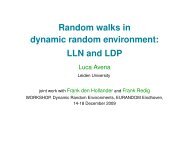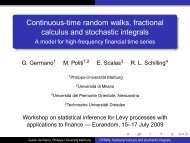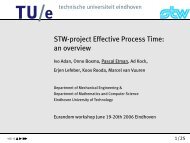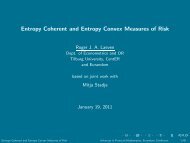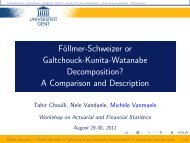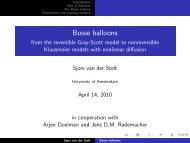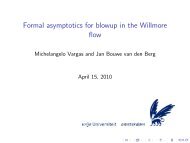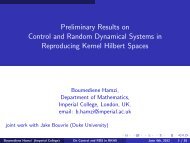EURANDOM
EURANDOM
EURANDOM
You also want an ePaper? Increase the reach of your titles
YUMPU automatically turns print PDFs into web optimized ePapers that Google loves.
Queueing and Performance Analysis (QPA)<br />
Ahmad Al Hanbali<br />
We developed a general framework to analyze polling systems with either the autonomous-server or<br />
the time-limited service discipline. We consider Poisson batch arrivals and phase-type service times. It is<br />
known that these disciplines do not satisfy the well-known branching property in polling system.<br />
Therefore, hardly any exact results exist in the literature. Our strategy is to apply an iterative scheme<br />
that is based on relating in closed-form the joint queue-length at the beginning and the end of a server<br />
visit to a queue. These kernel relations are derived using the theory of absorbing Markov chains.<br />
We study the transient behavior of a state dependent M/M/1/K queue during the busy period. We derive<br />
in closed-form the joint transform of the length of the busy period, the number of customers<br />
served during the busy period, and the number of losses during the busy period. We differentiate between<br />
two types of losses: the overflow losses that are due to a full queue and the losses due to the<br />
admission controller. For two special cases called the threshold policy and the static policy we determine<br />
simple expressions for their joint transform. Currently, extending these results for PH/PH/1/K<br />
queues that inlcude special cases like M/PH/1/K and PH/M/1/K queues.<br />
Paul Beekhuizen<br />
Performance analysis of networks on chips.<br />
Networks on Chips (NoC) constitute an emerging paradigm for on-chip communication. NoCs are composed<br />
of a number of hardware elements (routers, links, network interfaces) that are connected to<br />
form a network, plus a set of rules (a communication protocol) that specify how the packets are routed<br />
through the network. To be economically viable, a NoC must be implemented on a very small area of<br />
the chip and must satisfy stringent cost constraints. This leads to a number of distinguishing features:<br />
(a) The queueing elements are switches with small buffers, suffering from Head-of-Line blocking;<br />
(b) The predominant routing mechanism is worm hole routing;<br />
(c) Flow control is used to limit the number of packets in the network and to avoid overflow at the receiver.<br />
These features give rise to challenging performance analysis questions that will be studied in a joint<br />
project of <strong>EURANDOM</strong> and Philips Research.<br />
Remco Bierbooms<br />
Together with Ivo Adan (TU/e) and Marcel van Vuuren (CQM), Remco Bierbooms has been working on<br />
tandem production lines, both for discrete and continuous materials. The goal is to obtain a good estimation<br />
for the throughput and total sojourn time.<br />
For productions lines with discrete products, they improved an existing method by Ivo Adan and Marcel<br />
van Vuuren by including dependence in successive service times. The new method gives better results<br />
for longer tandem lines and for high variance in service times. In general, the new method is<br />
more stable in the input parameters.<br />
For production lines with continuous material (i.e. fluid) they are building a completely new model,<br />
using decomposition and iteration. The challenge is to model starvation and blocking in the production<br />
line, which is done by modelling the behavior of each machine as a Markov chain. Results for machines<br />
with exponential up- and downtimes look promising, the step towards general type up- and<br />
downtime distributions will now be made.<br />
Marko Boon<br />
In 2009, Marko Boon has continued working on polling models under the supervision of Onno Boxma<br />
and Ivo Adan. They have studied some model variants, including reneging and varying arrival rates.<br />
Furthermore, together with Sandra van Wijk and Erik Winands, they have developed a closed-form approximation<br />
for the mean waiting times in polling systems.<br />
Josine Bruin<br />
Together with Jan van der Wal we looked at the possibility to construct a dynamic production strategy<br />
for a multi-item production system with multiple machines instead of just one. Using a similar approach<br />
as the one step improvement approach used for the single machine multi-item production system,<br />
we obtained a dynamic strategy for a system with two machines and lost sales.<br />
Further, we obtained nice results for the one step improvement approach for the system with one machine<br />
and backlog.<br />
<strong>EURANDOM</strong> Annual Report 2009 8



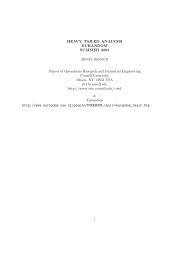
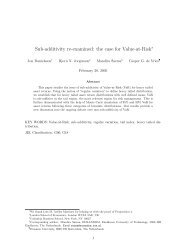
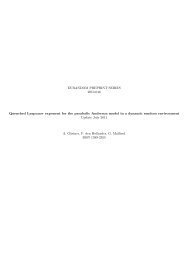
![The Contraction Method on C([0,1]) and Donsker's ... - Eurandom](https://img.yumpu.com/19554492/1/190x143/the-contraction-method-on-c01-and-donskers-eurandom.jpg?quality=85)
